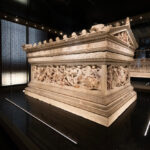Canda Mausoleum
Gothic
Charlotte Canda
1828-February 3, 1845
If this monument looks like it’s not well thought out and a bit unprofessional, it’s because its basic form was designed by a teenage girl and not a trained architect or designer. When she was sixteen years old, Charlotte Canda, whose French parents ran a finishing school in New York City, sketched a design for a memorial for her deceased aunt. Little did young Charlotte know that she was actually sketching a draft of a monument for herself.
February 3rd, 1845 was a dark and stormy night, but the weather scarcely put a damper on Charlotte Canda, who was all aglow from her combination seventeenth birthday and coming out party. Charlotte and her father, Charles Canda gave one of her friends a carriage ride to her Waverly Place home in Manhattan, but as Charlotte’s father was escorting her friend to the door, the horses, perhaps afraid in the raging storm, bolted and ran. The carriage careened through the streets of Manhattan with Charlotte still inside. Alas, the carriage door had been left ajar and a short time later young Charlotte Canda tumbled out of the carriage and violently hit her head on the curb. Unaware of what had happened, Charles Canda searched for Charlotte then found his way home. Shortly after he arrived home he and his wife were summoned to the place where Charlotte was ejected from the carriage. The couple arrived and Charlotte succumbed in her father’s arms soon thereafter.
Charlotte Canda was interred at the Old St. Patrick’s Cathedral on Prince and Mott street in Manhattan. But soon thereafter her father took Charlotte’s sketch for her aunt’s grave, added a few flowery embellishments and turned it over to sculptor Robert Launitz to finish the design and craft a suitable monument. Most of the monument was executed by Launitz and fellow sculptor John Franzee. The result of the Canda/Launitz collaboration has the look of a Gothic Revival wedding cake. Over a century of exposure to the elements makes the ornaments on the marble monument appear to be melting. In the center of the monument and housed in a structure reminiscent of a grotto (a cave-like structure often seen in Catholic cemeteries), Launitz carved a statue of Charlotte in the party dress she wore that fateful night. The Canda monument is awash with symbolism. There are books (Charlotte was fluent in five languages), musical instruments she played, drawing tools she used for her sketches, down-turned torches signifying a life extinguished but one that still burns in the hereafter, parrots that were her pets and seventeen roses circling her head. Further symbolizing her age is the dimensions of the monument: it is seventeen feet high and seventeen feet long.
To add a touch of Romeo and Juliet to the Canda saga, her despondent fiancé, French nobleman Charles Albert Jarrett de la Marie (1819-1847) took his own life two years later. Charlotte had been buried on consecrated ground, but because Charles had committed suicide, he could not be buried with his bride-to-be. Charles lies in unconsecrated ground just off to the right under a small upright tombstone with his family’s coat of arms.
The entire ensemble cost upwards of $45,000 (over one-million dollars today). From the time of the monument’s erection in 1847 all the way through the 1850’s it was the most popular monument in Green-Wood (indeed, some accounts say it was the most popular monument in all America). For years crowds gathered around the monument on Sundays paying their respects to a life cut tragically short.
In 1899, Daniel Pelton published a collection of poems he had penned over the years. Page 48 of Greenwood: An Elegy Meditations Among The Tombs reads:
CHARLOTTE CANDA.
Turn’d to the left, I seek the intricate round,
Where Charlotte Canda decorates the ground,
Like Sirius, fairest of the starry line.
Yet death seems setting on that heavenly shrine;
All tombs around are in its splendor lost,
And all must bow before its mighty cost.
Yet who would envy, who would take her place,
Though not possessed of any wealth or grace.
The dread of pain, tenacity of life,
Increase with woe, and feed on mortal strife;
In vain the roses round her bloom,
Vain may the polished marble shine,
In vain the sculptured image show
Charlotte in life almost divine.
Still all is night beneath the gorgeous tomb,
And the black grave wears the same dismal gloom.
Thou lovely flower, too delicate for earth,
‘Tis only strange such beauty here had birth;
Supine it fell before the autumnal blast
To rise to Heaven when wintry storms have passed
Photo and text © Douglas Keister Visit Doug’s Author Page
[address cemetery=”Green-Wood Cemetery” street=”Willow Avenue” city=”Brooklyn” state=”New York” zip=”11218″]

